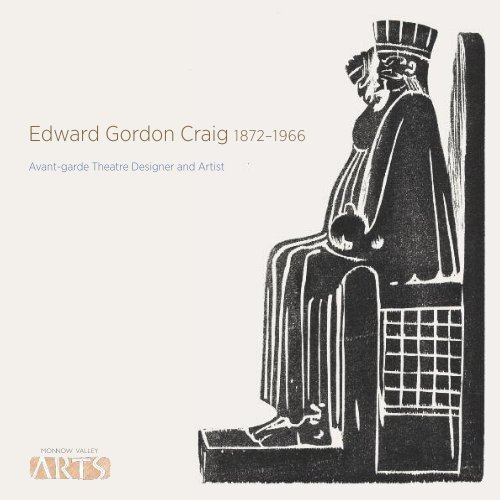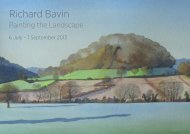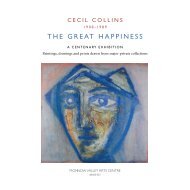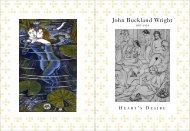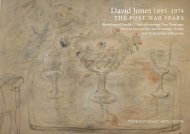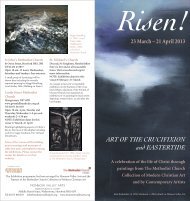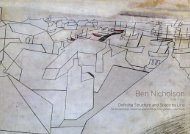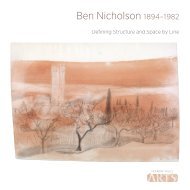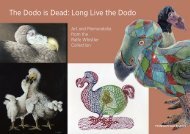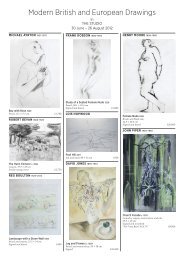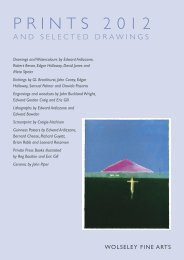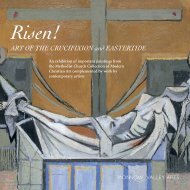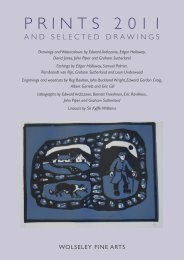Downloadable PDF of the catalogue. - Monnow Valley Arts Centre
Downloadable PDF of the catalogue. - Monnow Valley Arts Centre
Downloadable PDF of the catalogue. - Monnow Valley Arts Centre
You also want an ePaper? Increase the reach of your titles
YUMPU automatically turns print PDFs into web optimized ePapers that Google loves.
Edward Gordon Craig 1872–1966Avant-garde Theatre Designer and ArtistMONNOW VALLEY
AcknowledgementsThis <strong>catalogue</strong> has been produced in conjunctionwith <strong>the</strong> exhibitions at <strong>the</strong> <strong>Monnow</strong> <strong>Valley</strong> <strong>Arts</strong><strong>Centre</strong> and The School <strong>of</strong> Art Gallery andMuseum, University <strong>of</strong> Aberystwyth during 2010and 2011.I am extremely grateful to all those who havehelped in <strong>the</strong> preparation <strong>of</strong> <strong>the</strong> exhibition. Inparticular I would like to thank Michael Meredith<strong>of</strong> Eton College for his help in cataloguing itemsand for supporting <strong>the</strong> loan <strong>of</strong> works from <strong>the</strong>College’s collection; Veronica Franklin-Gould forher enthusiastic support <strong>of</strong> <strong>the</strong> project and herinvaluable sources, and Dr Lindsay Newman forcorrecting my pro<strong>of</strong>s and sharing her knowledge <strong>of</strong>Gordon Craig and his life.I am also grateful to <strong>the</strong> Provost and Fellows <strong>of</strong>Eton College for permission to borrow andreproduce works from <strong>the</strong>ir own collections and toNeil Jennings for o<strong>the</strong>r loans that have enhanced<strong>the</strong> selection <strong>of</strong> works we are able to show.The exhibition travels to <strong>the</strong> School <strong>of</strong> ArtGallery and Museum at <strong>the</strong> University <strong>of</strong>Aberystwyth and I am grateful to Robert Meyrickfor agreeing to host <strong>the</strong> exhibition.Finally I would like to express my thanks toHelen Craig, who is <strong>the</strong> daughter <strong>of</strong> Edward Craigand grand-daughter <strong>of</strong> EGC, for providing <strong>the</strong>foreword to <strong>the</strong> <strong>catalogue</strong>.Rupert OttenSeptember 2010Contact details and information on opening hours<strong>Monnow</strong> <strong>Valley</strong> <strong>Arts</strong> <strong>Centre</strong>Telephone: 01873 860529Email: info@monnowvalleyarts.orgwww.monnowvalleyarts.orgSchool <strong>of</strong> Art Gallery & Museum, University <strong>of</strong> AberystwythTelephone 01970 622460Email: museum@aber.ac.ukwww. aber.ac.ukCatalogue written by Rupert Otten, Foreword by Helen CraigDesigned by Helen Swansbourne, LondonPrinted by ABC Print (Hereford) Ltd in an edition <strong>of</strong> 500 copiesISBN 978-0-95595755-0Illustrations:Front cover: King Claudius and Queen Gertrude 1910, cat. 48Above: Frontispiece illustration to Gordon Craig’s Book <strong>of</strong> Penny Toys 1899, cat. 12Title page: Bookplate 1901, cat. 95Inside back cover: Julius Caesar 1922 (with Edward Craig), cat. no. 105Back cover: The Storm – King Lear 1920, cat. no. 62
Edward Gordon Craig 1872–1966Avant-garde Theatre Designer and ArtistStage Designs and Photographs, Drawings, Engravings, Woodcuts and EtchingsCatalogue by Rupert OttenForeword by Helen CraigE X H I B I T I O N DAT E S<strong>Monnow</strong> <strong>Valley</strong> <strong>Arts</strong> <strong>Centre</strong>Middle Hunt House, Walterstone, Herefordshire HR2 0DY2 October – 14 November 2010School <strong>of</strong> Art Gallery & MuseumUniversity <strong>of</strong> Aberystwyth, Buarth Mawr, Aberystwyth, Ceredigion CY23 1NG29 November 2010 – 28 January 2011MONNOW VALLEY <strong>Arts</strong> CENtrEExhibition organised by <strong>Monnow</strong> <strong>Valley</strong> <strong>Arts</strong>Middle Hunt House, WalterstoneHerefordshire HR2 0DYTel: 01873 860529, E mail: info@monnowvalleyarts.orgwww.monnowvalleyarts.orgM M X
ContentsForeword 4Biography 5CataloguePhotographs <strong>of</strong> EGC 6EGC as Graphic Artist and Designer 8Stage Screens 12Precursors to Hamlet 14EGC and Hamlet 16Black Figures 18O<strong>the</strong>r Engravings used in Hamlet 20O<strong>the</strong>r Theatrical Activities 22O<strong>the</strong>r Black Figures 24O<strong>the</strong>r Engravings and Etchings 26Bookplates 28Miscellaneous 30FrontispieceSelf Portrait 1919Lithographic reproduction <strong>of</strong> woodcut, 14.7 × 8.5 cmTitle and signature in letter-press, signed and dated lower rightBased on woodcut black figure (Black Figures 87)Books 32
ForewordThe powerful presence <strong>of</strong> my grandfa<strong>the</strong>r Edward Gordon Craig wasalways around when my bro<strong>the</strong>r and I were children.I only met him twice or I should say he met me twice because Idon’t remember <strong>the</strong> first time as I was a baby. He called me “The WildWoman <strong>of</strong> Borneo” – I wonder what prompted that – I was not <strong>the</strong>easiest <strong>of</strong> children.The second time we met was in 1956 when I visited him in Vencein <strong>the</strong> south <strong>of</strong> France for a few days. I was twenty-two years old. I didnot know what to make <strong>of</strong> this flamboyant and ra<strong>the</strong>r self-centred oldman. To make things more complicated his last daughter who was twoyears younger than me (and so my aunt!) decided to visit at <strong>the</strong> sametime. I was <strong>the</strong>n beginning a photographic career and managed to takea few good pictures <strong>of</strong> him.So as a child I only knew EGC through <strong>the</strong> books and picturesaround <strong>the</strong> place. In some ways this presence was benign and far awayas by <strong>the</strong>n he was living in France but in some ways it was threatening.How could I ever be an artist and match up to such a huge personality?I think this must be a problem for many <strong>of</strong>fspring <strong>of</strong> clever people.I was always aware <strong>of</strong> his greatness but I also felt (throughoverheard conversations and observations <strong>of</strong> those around me) thatto get too near to him would be to get sucked into some sort <strong>of</strong>service to this great genius. If I wanted to retain my own identityand achieve something for myself I would have to turn my back,set my own course and find something quite different to do. It tookmany years.Now that I am on <strong>the</strong> last lap <strong>of</strong> my life with a certain smallfulfilment in my own field <strong>of</strong> children’s book illustration I find I amable to really appreciate and more importantly enjoy <strong>the</strong> work <strong>of</strong> thisamazing grandfa<strong>the</strong>r <strong>of</strong> mine.I am constantly astonished at <strong>the</strong> amount <strong>of</strong> work he did plus <strong>the</strong>variety – watercolours, woodcuts, wood engravings, paintings andwonderful line drawings. Some <strong>of</strong> his line work is <strong>the</strong> most beautifulI have seen – and such a brave imagination – he never seemedfrightened to put down what was in his mind, however strange.I am always discovering work <strong>of</strong> his that I had never seen before.Even if I still don’t understand all his <strong>the</strong>ories about <strong>the</strong> <strong>the</strong>atre I amenjoying his brilliant images now as I never could when a child.I am so happy that Rupert Otten has taken it upon himself to putthis extensive exhibition <strong>of</strong> Edward Gordon Craig’s work toge<strong>the</strong>r andto bring it to an area o<strong>the</strong>r than <strong>the</strong> capital.Helen Craig, 20104
Biography1872 Born Stevenage, Hertfordshire, <strong>the</strong> son <strong>of</strong><strong>the</strong> architect Edward Godwin and <strong>the</strong>actress Ellen Terry. Named as Edward HenryGordon.1879 First appearance on stage in Olivia, aged 6.1885 Accompanied his mo<strong>the</strong>r and <strong>the</strong> LyceumCompany to America.1886 Sent away to school at Southfield Park andlater Bradfield College.1889 Became an actor under Sir Henry Irving.1893 Married May Gibson and changed his nameby deed poll to Edward Gordon Craig.Known as Teddy or EGC.1893 First stage designs and productions.First attempts at wood engraving under <strong>the</strong>influence <strong>of</strong> William Nicholson and JamesPryde.1897 Starts affair with Elena Meo with whom hehas two children, Nelly and Edward.1898 Attempted to earn a living from makingwoodcuts and design work. Published ThePage until 1902.1899 Abandoned his career as an actor.Worked on various stage productions up to1914.1905 Published The Art <strong>of</strong> <strong>the</strong> Theatre.1906Had daughter with Isadora Duncan.Settles in Florence.1908 Acquired lease on Arena Goldoni. Editedand published The Mask until 1929.1910 Craig patented his moveable stage screens.1911 Designed and produced Hamlet for MoscowArt Theatre using his new screens1929 Last stage production. Publication <strong>of</strong>Cranach Press Hamlet.1930 Publication <strong>of</strong> his book on Henry Irving.1932 Publication <strong>of</strong> Ellen Terry and Her SecretSelf.1957 Publication <strong>of</strong> Index to <strong>the</strong> Story <strong>of</strong> My Days1872–1909.1966 Died at Vence, France.1 (part)5
Photographs <strong>of</strong> CraigThe provenance <strong>of</strong> all photographs is TomCraig, grandson <strong>of</strong> Edward Craig (also knownas Edward Carrick), film designer, author andengraver.1. EGC in The Dead Heart, Lyceum Theatre18896.6 × 3.9 cm, unknown photographerwithEGC outside Barkston Gardens 189219 × 15 cm, photograph taken by Edy Craig(modern print)Illustrated on page 542. EGC c. 191032 × 25 cm top left corner missing laid down onboard, unknown studio photographerInscribed property <strong>of</strong> Edward Carrick onreverse4623. Photograph <strong>of</strong> EGC in England 1911/1220.8 × 11.3 cm, unknown photographer4. EGC on arrival at Moscow Station 27March 193514 × 20.7 cm, unknown photographerFrom left to right: Amaglobeli, Tair<strong>of</strong>f, EGC,Chernyavski, MeyerholdwithEGC at <strong>the</strong> Mali Theatre, Moscow 193514.4 × 22.8 cm, unknown photographer. EGCcentre, o<strong>the</strong>rs unidentified.
85. EGC at St. Germain-en-Laye with Dora194123.5 × 17 cm, unknown photographer6. EGC with <strong>the</strong> Duke and Duchess <strong>of</strong>Leinster and party near Grasse c. 19495.8 × 5.2 cm, photograph by Edward Carrick57. EGC with David Lees at Tourettes-sur-Loup c. 195613.7 × 9.2 cm, unknown photographerDavid Lees was EGC’s sonwithEGC with his White Cat 195815.6 × 10.8 cm, photograph by Joe Hollander8. EGC in a deckchair c. 195623.3 × 29.3 cm, photograph by David Lees9. EGC Writing c. 195629.6 × 23.7 cm, photograph by David LeesInscribed Picture Post on reverse.97
EGC as Graphic artist and DesignerEGC married May Gibson in 1893 and settled inUxbridge a short distance from where WilliamNicholson and James Pryde were living. Thesetwo artists were known as <strong>the</strong> Beggarstaff andproduced innovative modern designs inwoodcuts and engravings. EGC learnt from<strong>the</strong>m and by trial and error became a successfuldesigner and engraver. EGC also wrote andillustrated books including Penny Toys in 1899.There is some confusion as to whe<strong>the</strong>r <strong>the</strong>seearly prints were cut on <strong>the</strong> end or long grain <strong>of</strong>woodblocks. Tom Craig, EGC’s grandson,believes that EGC practised wood engraving andthat only <strong>the</strong> black figures, which evolved out <strong>of</strong>miniature stage sets, were technically woodcuts.Haldane Macfall in <strong>the</strong> Print Collector Quarterlyvolume 9, no. 4, published in 1922, describesEGC’s work as woodcuts and EGC in his ownpublication Woodcuts and Some Words,J.M. Dent & Sons, 1924, continues to describe<strong>the</strong>se works as woodcuts. We have used thisterminology in this <strong>catalogue</strong>.1010. Cover Design for The Dome 1897Woodcut partially coloured, 12.7 × 9.6 cm11. Miss Ellen Terry as Ophelia 1898Pro<strong>of</strong> woodcut, 24.5 × 15.5 cmAn additional impression with title and EGCinitials in letter-press as published in The Page,Vol. I, is also available12. Frontispiece illustration to Gordon Craig’sBook <strong>of</strong> Penny Toys 1899Pro<strong>of</strong> woodcut with highlights in handcolouring, 10 × 7 cmIllustrated on inside front cover811
13. Pro<strong>of</strong> Illustration to Gordon Craig’s Book <strong>of</strong>Penny Toys 1899Pro<strong>of</strong> hand coloured woodcut, 12 × 15 cmEGC’s first book was published in 189914. Miss Ellen Terry c. 1898Woodcut, 10 × 8.8 cm15. Sir Henry Irvine as Macaire c. 1900Hand coloured woodcut, 17.8 × 11.4 cmLetter-press title. Issued as a supplement toThe Page, Vol. III1316. Battersea Park c. 1900Woodcut, 9.8 × 13.2 cmLetter-press title and signature as issued inThe Page, Vol. IV17. I had no Thoughts <strong>of</strong> a Blue Gauze Veilc. 1900Woodcut, 10.2 × 10.2 cmLetter-press title and inscribed “Designed andEngraved by Oliver Bath” (nom de plume <strong>of</strong>EGC) as issued in The Page, Vol. III161714159
181918. Peer Gynt’s Nephew c. 1900Woodcut, 7.8 × 9.8 cmLetter-press title and inscribed Anunfinished woodcut by Oliver Bath(nom de plume <strong>of</strong> EGC) as issued inThe Page, Vol. IV19. Kensington Gardens 1901Woodcut, 12.5 × 14.9 cmSigned and numbered 3/18An additional impression as issued forThe Page Vol. IV with letter-press title andsignature20. Tom Foolery c. 1900Woodcut, 8.1 × 6.7 cmLetter-press title and inscribed Designed by<strong>the</strong> late Oliver Bath (nom de plume <strong>of</strong>EGC) as issued in The Page, Vol. IV21 The Sorceress (for Dido and Aeneas)1900Woodcut, 17.6 × 9.2 cmLetter-press title and signature as issued inThe Page, Vol. III22. Irving as Badger in The Streets <strong>of</strong>London c. 1900Woodcut, 10.8 × 8.3 cmLetter-press title and signature as issued inThe Page, Vol. III1022 21
202523. The Understudy c. 1900Woodcut, 7.8 × 7.8 cmLetter-press title and signature as issued inThe Page2424. Parochial Marmalade (design for a label)1900Pro<strong>of</strong> woodcut, 9.5 × 11.2 cmIllustrated Woodcuts and Some Words 1924,No. 1725. Costume Design for Bethlehem 1903Pro<strong>of</strong> woodcut, 16.7 × 12.9 cmIllustrated ‘Concerning <strong>the</strong> Woodcuts <strong>of</strong>Gordon Craig’, Print Collector Quarterly 1922,page 406 and Woodcuts and Some Words 1924,No. 2126. Combat by Pyramid c. 1906Woodcut, 5.8 × 5.8 cmSigned, dated and numbered 38/120262311
Stage ScreensEGC first went on <strong>the</strong> stage as a 6-year-old in1878. A few years later he toured America withhis mo<strong>the</strong>r, Ellen Terry. In 1889 he wasapprenticed to Sir Henry Irving and became afine actor under his guidance. However, despitehis success as an actor he became dissatisfiedwith <strong>the</strong> ways in which plays were performed.In 1899 he was <strong>of</strong>fered <strong>the</strong> chance to plan aproduction <strong>of</strong> Dido & Aeneas for <strong>the</strong> PurcellOperatic Society. With <strong>the</strong> design skills he hadtaught himself through his woodcuts, heproduced imaginative designs for <strong>the</strong>production. Footlights would be discarded infavour <strong>of</strong> light from <strong>the</strong> side and above. Scenerywas kept to a minimum.The Purcell Operatic Society flourished andCraig’s reputation was secured as adesigner/director. With <strong>the</strong> help <strong>of</strong> his mo<strong>the</strong>r,new opportunities afforded <strong>the</strong>mselves withproductions <strong>of</strong> Bethlehem by LaurenceHousman in 1902, The Vikings in 1904 andMuch Ado About Nothing. EGC worked on ideasfor productions <strong>of</strong> King Lear and Hamlet.The experience <strong>of</strong> directing plays led EGCto articulate his <strong>the</strong>ories about a new <strong>the</strong>atre.Whilst in Germany in 1905 he wrote a smallbook, The Art <strong>of</strong> <strong>the</strong> Theatre, in which heexplained his <strong>the</strong>ory that a <strong>the</strong>atricalproduction should aim to show <strong>the</strong> innerbeauty and meaning <strong>of</strong> life. For EGC this alsomeant that scenery should be simple anddramatic.In 1910 he patented his ideas forImprovements in Stage Scenery in whichscenery would be provided by ways <strong>of</strong> hingedscreens which could be moved around <strong>the</strong> stageeasily and would help create dramatic lightingeffects. It would be cheap to make and easy toinstall.His ideas were adopted immediately by <strong>the</strong>Abbey Theatre in Dublin and most importantlyby <strong>the</strong> Moscow Art Theatre where EGC wasinvited to produce Hamlet in 1911. The playusing his ingenious staging ran for 3 seasonsuntil 1914.27. Dame Ellen Terry posing in front <strong>of</strong> StageScreens 1910Photograph, 10.7 × 15.3 cm, a reprint fromoriginal negative by Edward CarrickwithPhotograph <strong>of</strong> Act 1, Scene 2 for Hamlet c. 191114.7 × 18.8 cm, photo by The Central News Ltd.withPhotograph <strong>of</strong> Act V, Scene 1 for Hamlet 191110.8 × 15.5 cm, a reprint by Edward Carrickfrom <strong>the</strong> original negative <strong>of</strong> <strong>the</strong> model with agroup <strong>of</strong> black figureswithPhotograph <strong>of</strong> Act IV scene 6 for Hamletc. 191110.8 × 15.4 cm, a reprint by Edward Carrickfrom <strong>the</strong> original negative <strong>of</strong> a figurerepresenting a sailor on stairsNote: <strong>the</strong> figure on <strong>the</strong> stairs is based on amodel <strong>of</strong> Rosencrantz who according toChristopher Innes is doubling up for <strong>the</strong> sailorwho makes only one appearance in Hamlet.27 (part)12
28. Photograph <strong>of</strong> Act IV, Scene 5, Hamletc. 191026.4 × 30 cm, photograph by Edward Carrickfrom <strong>the</strong> model EGC made in 1909 with <strong>the</strong>black figure Ophelia with Flowers.29. Photograph <strong>of</strong> an experimental stage setprobably taken at Smallhy<strong>the</strong> 1910 or 191120.8 × 14.7 cm, contemporaneous photographfrom <strong>the</strong> scale model with two black figures, oneprobaly Jew.292813
Precursors to HamletEGC left Britain in 1904 for Germany and from<strong>the</strong>re travelled to Florence where he arrived in1905. He established his base from 1908 at <strong>the</strong>Arena Goldoni. From Florence he promulgatedhis ideas for modern <strong>the</strong>atre through hismagazine The Mask, through his Marionettes,writing, engravings and etchings.30. Weep you no More, Sad Fountains 1906Watercolour and pen and inkSigned, annotated and datedA gift to <strong>the</strong> musician Martin Shaw, a greatfriend and artistic collaborator <strong>of</strong> Craig’s.31. Design for a Scene 1907Etching, 20.6 × 16.5 cmSigned and dedicated and dated 191032. Design for a Scene c. 1907Etching on repaired PWP & AOL handmadepaper, 8.2 × 6 cmFaint initials below plate on right resembling asignature33. Light 1907Etching, 20.2 × 12.7 cmSigned and dated331431 32
353434. Descending into <strong>the</strong> Tomb 1907Etching, 20.6 × 16.7 cmSigned and dated from A Portfolio <strong>of</strong> EtchingsOnly 12 sets completed35. In Italy – A Design for a Scene 1907Wood engraving, 10.5 × 8.8 cmSigned lower right with initialsAlso pro<strong>of</strong> impression available36. Scene 1908Pro<strong>of</strong> woodcut, 12.2 × 8.2 cm3615
EGC and HamletThe earliest known drawings for a Hamletproduction date to around 1903, but it was notuntil 1909 – when Konstantin Stanislavski askedhim to direct a production <strong>of</strong> Hamlet at <strong>the</strong>Moscow Art Theatre – that Craig became fullyengaged on <strong>the</strong> <strong>the</strong>me. Having designed <strong>the</strong>moveable screens and patented <strong>the</strong>m in 1910,he started to plan <strong>the</strong> action using <strong>the</strong>se scalemodels <strong>of</strong> <strong>the</strong> screens and wooden figures asminiature representations <strong>of</strong> actors which heplaced against <strong>the</strong> screens.It took nearly three years and several tripsto Moscow to get <strong>the</strong> production ready. Itopened in January 1912. Many technicalinnovations including <strong>the</strong> use <strong>of</strong> <strong>the</strong> foldingscreen and overhead and side lighting made <strong>the</strong>production a milestone in <strong>the</strong>atricaldevelopment. The production was a majorsuccess and continued for three seasons inMoscow and St. Petersburg, closing in 1914.EGC already knew Count Harry Kessler(1868–1937), diplomat and founder <strong>of</strong> <strong>the</strong>Cranach Press, and had collaborated with himin Germany in 1904/5. Kessler having seenCraig’s model <strong>the</strong>atre and stage designs with <strong>the</strong>wooden figures, suggested that prints madefrom <strong>the</strong> wooden figures could be used to makean illustrated version <strong>of</strong> Hamlet.A new typeface was commissioned andEGC was to make black figure engravings basedon his original wooden figures and supplement<strong>the</strong>se with additional wood engravings. Thefirst world war intervened and it was not until1929 that <strong>the</strong> book was published, first inGerman and <strong>the</strong>n re-set with a new suite <strong>of</strong>illustrations in English. It was superblyproduced on handmade paper and handprinted. It contains 74 woodcuts or engravingsin <strong>the</strong> German edition and 80 in <strong>the</strong> Englishedition by EGC and one wood engraving as titlepage by Eric Gill. It was printed in editions <strong>of</strong>255 and 325 copies respectively and includedsome specials with extra suites <strong>of</strong> prints. Itremains one <strong>of</strong> <strong>the</strong> most sought after books <strong>of</strong><strong>the</strong> Cranach Press.1638
3737. Design for Hamlet 1910Black crayon, 13.3 × 20.5 cmOne <strong>of</strong> <strong>the</strong> earliest known set designs forHamletKindly lent and reproduced by permission <strong>of</strong><strong>the</strong> Provost and Fellows <strong>of</strong> Eton College,Berkshire38. Act one, Scene one, Hamlet c. 1910Pencil, 9.5 × 14.4 cmKindly lent and reproduced by permission <strong>of</strong><strong>the</strong> Provost and Fellows <strong>of</strong> Eton College,Berkshire39. Photographs <strong>of</strong> Act I, Scene I c. 191017 × 22.8 cm, 13 × 17.5 cm and 12.3 × 16 cmKindly lent by <strong>the</strong> Provost and Fellows <strong>of</strong> EtonCollege, Berkshire17
Black FiguresEach figure was carved on <strong>the</strong> long grain <strong>of</strong> ablock <strong>of</strong> s<strong>of</strong>t wood with <strong>the</strong> outline and detailsengraved upon <strong>the</strong> surface. These blocks werelater used to make editions <strong>of</strong> prints and foruse, toge<strong>the</strong>r with some new wood engravings,in <strong>the</strong> German and English editions <strong>of</strong> <strong>the</strong>Cranach Press version <strong>of</strong> Hamlet.The Black Figures <strong>of</strong> EGC were listed by Dr.Lindsay Newman and <strong>the</strong> numbering and noteson where <strong>the</strong> blocks have been used follows <strong>the</strong>treatment given in Black Figures, presented withintroduction & documentation by L.M. Newman,Christopher Skelton 1989 and from o<strong>the</strong>runpublished lists.40. Ghost with Crown 1912Woodcut, 15.7 × 5.4 cmSigned, edition <strong>of</strong> 4 or 5Kindly lent by <strong>the</strong> Provost and Fellows <strong>of</strong> EtonCollege, Berkshire41. Ophelia Sane 1927Woodcut (Black Figures 3 recut version),14 × 6.5 cmSigned, edition <strong>of</strong> 1342. Ophelia Mad 1912Woodcut (Black Figures 4, 6th state) on yellowpaper, 15 × 8.6 cmTitled and inscribed Pro<strong>of</strong> Impression ! TheShadows at <strong>the</strong> right bottom corner cut out !Used on <strong>the</strong> 8 deluxe copies <strong>of</strong> Hamlet1841 4245
43. Hamlet and Daemon (large) 1909Woodcut (Black Figures 8, 2nd state),24.2 × 11.7 cmSigned and dated, edition <strong>of</strong> 40. Used in TheMarionette I 191844. Actor (three quarter length) 1912Woodcut (Black Figures 16, Block 1) on yellowpaper, 15.8 × 6.3 cmEdition <strong>of</strong> about 8 impressions on yellow, total27 copiesUsed on page 72 <strong>of</strong> <strong>the</strong> German edition <strong>of</strong>Hamlet48. King Claudius and Queen Gertrude 1910Wood cut, 24.8 × 15.1 cm (Black Figures U-10)Printed by Helen and Edward Craig c. 1987 inan edition <strong>of</strong> about 10 onlyIllustrated on front cover49. King Claudius 1910Woodcut (Black Figures U-11), 23.5 × 6.7 cmPrinted by Helen and Edward Craig c. 1987 inan edition <strong>of</strong> about 10 only45. Actor (three quarter length) 1930Woodcut (Black Figures 16, Block 2) on vellum,10.8 × 4.8 cmSigned in pencil, edition <strong>of</strong> 6. Recut in smallersize for <strong>the</strong> English edition <strong>of</strong> Hamlet, page 644346. Yorick 1913Woodcut on vellum (Black Figures 19),15.4 × 7.9 cm, edition 25 copiesSigned with initials, printed by EGC and givento Count Harry KesslerUsed on page 155 <strong>of</strong> German version and page151 <strong>of</strong> English edition <strong>of</strong> Hamlet47 Hamlet Pr<strong>of</strong>ile 1913Wood cut on Japanese vellum (Black Figures 31,2nd state), 6.3 cm diameter, edition <strong>of</strong> 23Used on cover <strong>of</strong> some copies <strong>of</strong> <strong>the</strong> fullmorocco Hamlet47 464919
O<strong>the</strong>r Engravings used in Hamlet50. Screen Fragment for Hamlet 1913Woodcut on japon, 7.7 × 2.2 cm, editionunknownUsed on page 164 <strong>of</strong> <strong>the</strong> English edition <strong>of</strong>Hamlet51. Ghost Bursting Cerements 1925Wood engraving, 12.3 × 16 cmSigned and datedKindly lent by <strong>the</strong> Provost and Fellows <strong>of</strong> EtonCollege, Berkshire52. Hamlet on Cushions 1927Wood engraving (Black Figures 37A) on yellowjapan, 8.2 × 10.2 cmAn unsigned pro<strong>of</strong> apart from <strong>the</strong> edition <strong>of</strong> 15522053
5053. Ophelia with Window 1928Wood engraving in blue ink (Black Figures37VV), 9 × 18 cmSigned. Used on page 129 <strong>of</strong> <strong>the</strong> Englishedition,54. Lights, Lights, Lights c. 1928Wood engraving (Black Figures 37MM),7.8 × 18.2 cmSigned55. King Sleeping c. 1928Wood engraving (Black Figures 37KK),7.8 × 18.2 cmSigned56. S: Initial with Gravediggers 1930Presentation pro<strong>of</strong> wood engraving (BlackFigures 82C), 7.9 × 7.5 cmSigned. Used on page 146 <strong>of</strong> English edition <strong>of</strong>Hamlet54555621
O<strong>the</strong>r Theatrical ActivitiesAlthough EGC is best known for his designs forHamlet, throughout <strong>the</strong> early years <strong>of</strong> <strong>the</strong> 20thcentury he worked on productions in England,Germany and Italy. In his seminal book The Art<strong>of</strong> <strong>the</strong> Theatre, published in 1905, he wasconsidering <strong>the</strong> role <strong>of</strong> <strong>the</strong> actor and exploring<strong>the</strong> impact that marionettes might have on <strong>the</strong>visual experience <strong>of</strong> <strong>the</strong> audience.Once established in Florence, EGC mademarionettes and published a regular magazineas part <strong>of</strong> The Mask on <strong>the</strong> role and use <strong>of</strong>marionettes. EGC made a set <strong>of</strong> designs for KingLear in 1908 which were not used. He wantedcomplete control over his productions and this<strong>of</strong>ten caused difficulties with producers and ledto many aborted projects.57. The Marionette 1918Pen and ink drawing, 11 × 7 cmToge<strong>the</strong>r with a subscription form for TheMarionette A Monthly Performance withhand-written draft letter in pencil to Martin(Shaw) with a printed Motion for Romeo andJuliet58. Illustration for The Three Men <strong>of</strong> Gotham1919Probably made in collaboration with EdwardCraigOriginal ink drawing, 3 × 15.2 cm and a handcolouredplate issued with <strong>the</strong> MarionetteMotion59. Advertisements for The Mask c. 1920For <strong>the</strong> US market, subscription $2.50 or$5 per annumFor <strong>the</strong> UK market, 2/6 a copy or10/- per annum60. Venice Preserved 1913Plan <strong>of</strong> <strong>the</strong> model for Venice Preserved in ink,10.2 × 12.5 cmPhotograph <strong>of</strong> an enlargement <strong>of</strong> an EGCdesign for basis <strong>of</strong> model, 10 × 7.4 cmColour photograph <strong>of</strong> watercolour <strong>of</strong> stagedesign, 15 × 10.5 cm2257 58
61. For King Lear 1908Wood engraving, 10.4 × 10.7 cmSigned and datedLiterature: Woodcuts and Some Words, no. 4462. The Storm – King Lear 1920Wood engraving, 16.8 × 15.8 cmSigned and dated 1924 above signature and1920 below printLiterature: Woodcuts and Some Words, no. 57Illustrated on back cover63 Photograph <strong>of</strong> <strong>the</strong> Great Model for Bach’sSt. Mat<strong>the</strong>w Passion 1913–1451 × 40.5 cm, with pencil and ink annotationson front and reverse by EGCProvenance: Edward Carrick64. La Procession Nocturne (Liszt) 1927Wood engraving, 10.9 × 17.9 cmSigned and numbered 38/100Provenance: Sir Nigel Hawthorne636423
O<strong>the</strong>r Black FiguresEGC made black figures for many o<strong>the</strong>rpossible productions including Don Juan, TheMerchant <strong>of</strong> Venice, Rosencrantz andGuildenstern and St. Mat<strong>the</strong>w Passion.65. Dancing Girl 1908Woodcut (Black Figures 66), 26.9 × 6.6 cmPrinted by Helen and Edward Craig c. 1987 inan edition <strong>of</strong> about 10 only66. Lorenzo (without stick) 1909Woodcut (Black Figures 43, 1st state),15.6 × 7.2 cmSigned and dated 1910, edition <strong>of</strong> 1067. Orator (Acrobat) 1908Woodcut (Black Figures U-7), 25.8 × 10 cmPrinted by Helen and Edward Craig c. 1987 inan edition <strong>of</strong> about 10 only65 6668. Eve 1915Woodcut (Black Figures 85, 3rd state),15.3 × 8.4 cmUnsigned but annotated. Only 35 Copies, thisone extra B69. Priest 1907/9Woodcut (Black Figures 80), 26.9 × 10 cmPrinted by Helen and Edward Craig c. 1987 inan edition <strong>of</strong> about 10 only70. Helena 1908Woodcut (Black Figures U-3), 25.8 × 9.5 cmPrinted by Helen and Edward Craig c. 1987 inan edition <strong>of</strong> about 10 only71. Worshipper 1907Woodcut (Black Figures 81), 26 × 6.8 cmPrinted by Helen and Edward Craig c. 1987 inan edition <strong>of</strong> about 10 only72. Moses 1909Lithographic reproduction <strong>of</strong> original woodcut(Black Figures 64), 26.6 × 9.6 cmInscribed by Emery Walker 1930, “very rare notfor sale”2467 68
73. Pleader (Penitent) 1908Woodcut (Black Figures U-5), 25.7 × 8 cmPrinted by Helen and Edward Craig c. 1987 inan edition <strong>of</strong> about 10 only74. Roman Actor 1907–8Woodcut (Black Figures 77), 25.8 × 12.4 cmPrinted by Helen and Edward Craig c. 1987 inan edition <strong>of</strong> about 10 only75. Mourner 1908Woodcut (Black Figures U-8), 25.5 × 7.8 cmPrinted by Helen and Edward Craig c. 1987 inan edition <strong>of</strong> about 10 only6970 7172 73 74 7525
O<strong>the</strong>r engravings and etchingsEGC originally learnt to cut woodcuts used asillustrations to books and as bookplates. After1900 he also learnt to cut wood engravings andfrom 1907, etchings. Two portfolios <strong>of</strong> etchingswere made by EGC in Florence and printed byLuigi Tassini. All are now very scarce items.76. Winchelsea 1900Pro<strong>of</strong> wood engraving, 4 × 7.7 cmLiterature: Woodcuts and Some Words, no. 137677. Torre dei Diavoli 1908Pro<strong>of</strong> wood engraving, 6.5 cm diameterFirst published in The Mask, Vol. ILiterature: Woodcuts and Some Words, no. 3478. View <strong>of</strong> Arcetri 1908Wood engraving, 6 × 14 cmSignedFirst published in The Mask, Vol. ILiterature: Woodcuts and Some Words, no. 4679. View over Florence 1908Wood engraving, 5.2 × 14.3 cmSignedFirst published in The Mask, Vol. IILiterature: Woodcuts and Some Words, no. 497780. La Commedia 1911Woodcut, 3.5 × 12.5 cmLiterature: Woodcuts and Some Words, no. 5681. The Globe Theatre c. 1908Pro<strong>of</strong> wood engraving, 4.2 × 4 cm82. Briars near Florence c. 1908Wood engraving, 17 × 7 cmSigned with initialsAn unsigned impression in red/brown ink isalso available83. Street Scene St. Germain-en-Laye 1938Pro<strong>of</strong> wood engraving in brown ink, 7 × 7.5 cmInscribed Final State. One <strong>of</strong> 3 copies, copy 22678
827980818327
BookplatesEGC made some 200 bookplates over his lifewith <strong>the</strong> first in 1895. These were made to earnmuch needed money to keep his young familyfed. However <strong>the</strong>y are an important contributionto modern design. EGC compiled hisbookplates in <strong>the</strong> publication BookplatesDesigned and Cut in Wood 1900 and in Nothingor <strong>the</strong> Bookplate 1924.References are to The Bookplates <strong>of</strong> EdwardGordon Craig by John Blatchly, The BookplateSociety 1997. Here <strong>the</strong> works are described aswoodcuts but today are better described aswood engravings as <strong>the</strong>y were made on <strong>the</strong>short grain <strong>of</strong> boxwood blocks.84. Arena Goldoni 1915, (Blatchly 2), plan <strong>of</strong>Goldoni Theatre, 9.4 × 8.1 cm85. Nina, Lady Corbet 1900 (Blatchly 18), pinkwith name, 5.6 × 2 cm86. The Hon. Mrs LA Tollemarche 1900(Blatchly 160iii), poodle, 6.7 × 5.7 cm87. Marion Terry 1899 (Blatchly 159), wreathwith initials, 9.2 × 6.1 cm88. Cora Brown Potter 1901 (Blatchly 125),Ex Libris and initials, 6.6 × 4.3 cm8485862887 88
89. Charles William Dalmon 1900 (Blatchly48), herb sprig with initials, 6.2 × 4.5 cm90. William Downing 1900 (Blatchly 62), shipat sea with name, 7.2 × 6 cm91. Jess Dorynne 1901 (Blatchly 58), woman inelaborate hat and cape, 4.6 × 3.9 cm92. No Owner 1901 (Blatchly 179), side view <strong>of</strong>mask, 3.2 × 2.5 cm93. Horah F Dryhurst (Blatchly 64), town onhill, 4.6 × 3.5 cm94. Beatrice Irwin 1901 (Blatchly 86i), snakewith halo in a box, first state, 5.1 × 5 cm95. Edward Gordon Craig 1901 (Blatchly 36),tree with initials and date, 4 × 2.6 cm(illustrated on title page)96. Alice, Lady Ridley 1901 (Blatchly 132),rose bush with initials, 7.9 × 3.9 cm97. Rowland James Corbet 1900 (Blatchly19ii), chick with name, 4.7 × 3 cm98. Daphne Woodward 1929(Blatchly 169), dividedbranch <strong>of</strong> foliage with initials,3.2 cm diameter99. No Owner 1899 (Blatchly 177),female figure in crinoline,4.5 × 2 cm90899192939429
Miscellaneous100. Drawing <strong>of</strong> d’Artagnan c. 1901Ink, 19 × 19 cmEGC admired d’Artagnan and thought <strong>of</strong>himself as like this fictional character101. Hillside 1901Monotype print, 9 × 14.5 cmA unique work from <strong>the</strong> Edward Craig archive102. Message sent 27 April 1941 from OccupiedFranceMessage sent under <strong>the</strong> auspices <strong>of</strong> <strong>the</strong>International Red Cross from EGC at 11 bis ruede Noailles, St Germain-en-Laye, to Nellie Craigin London with news <strong>of</strong> his internment andsubsequent release by <strong>the</strong> Germans. Red Crossstamp, censor stamps <strong>of</strong> British and NaziauthoritieswithMessage sent 11 June 1943 from occupiedFranceMessage sent under <strong>the</strong> auspices <strong>of</strong> <strong>the</strong>International Red Cross from EGC at 85 rueAmpère, Paris to his wife Elena Craig inHampstead, London, with general news <strong>of</strong> hiswell being. Red Cross stamp, censor stamps <strong>of</strong>British and Nazi authorities.10110230100
103104106103. Pensione Famille c. 1952Watercolour mounted on panel, 7 × 10.6 cmIn 1952 EGC moved to Tourettes-sur-Loopoutside Vence in <strong>the</strong> south <strong>of</strong> France104. Paysage c. 1965Watercolour, 8.2 × 11.9 cmInscribed by Edward Craig as EGC’s last(watercolour)105. Julius Caesar 1922 (with Edward Craig)Watercolour on reverse <strong>of</strong> Stedelijk MuseumDinner menu 6 February 1922, 10.6 × 15.9(Illustrated on inside back cover)withCesare Borgia c. 1925 (with Edward Craig)Watercolour, 10 × 15.3 cm106. Musician 1931Ink and watercolour, 14 × 14 cm107. Odysseus arrives at Crete c. 1935 (possiblywith Edward Craig)Watercolour and ink, 17 × 11 cmInscribed in inkand <strong>the</strong> essence <strong>of</strong> <strong>the</strong> abstract unravelling ahandy prudenceplays upon <strong>the</strong> foretold unity;while equity befooledby routine pausesin doubt behinda two-fold hateInscribed verso The cry <strong>of</strong> <strong>the</strong> experimenter10731
Books108. Scene 1923Written by EGC with a foreword by JohnMasefield, Oxford University Press, 30 × 24 cmHardback, number 60 <strong>of</strong> 100 signed by EGC out<strong>of</strong> a total edition <strong>of</strong> 1000109. Woodcuts and Some Words 1924By Edward Gordon Craig with an introductionby Campbell Dodgson, hardback. Published byJ.M. Dent & Sons. Book plate <strong>of</strong> Edward Craig110. Books and Theatre 1925By Edward Gordon Craig published by J.M.Dent & Sons hardback with dust coverBookplate <strong>of</strong> Edward Craig with Edward Craigpencil annotations throughout111. Index to <strong>the</strong> Story <strong>of</strong> my Days, somememoirs <strong>of</strong> Edward Gordon Craig, 1957By Edward Gordon Craig, published by HultonPress, London112. Gordon Craig: The Story <strong>of</strong> his Life 1968By Edward Craig, published by Alfred A. Knopf,New York113. Towards a New Theatre: Edward GordonCraig and Hamlet 1975By Brian Arnott in English and French,published by <strong>the</strong> National Gallery <strong>of</strong> Canada.114. Gordon Craig Archives 1976An international survey by L.M. Newmanpublished by The Malkin Press, London, in anedition <strong>of</strong> 500 copies115. Gordon Craig’s Moscow Hamlet: AReconstruction 1982By Laurence Senelick, hardback published byGreenwood Press116. The Black Figures <strong>of</strong> Edward Gordon Craig1989Presented with introduction anddocumentation by L.M. Newman, published byChristopher Skelton, hardback in an edition <strong>of</strong>500 copies117. The Bookplates <strong>of</strong> Edward Gordon Craig1997By John Blatchly, published by The BookplateSociety and Apsley House Press in an edition <strong>of</strong>400118. The White Fan, Gordon Craig’s NeglectedMasterpiece <strong>of</strong> Symbolist Staging 2009By L.M. Newman, published by The MalkinPress, London, marbled s<strong>of</strong>t cover in an edition<strong>of</strong> 225 copies32


